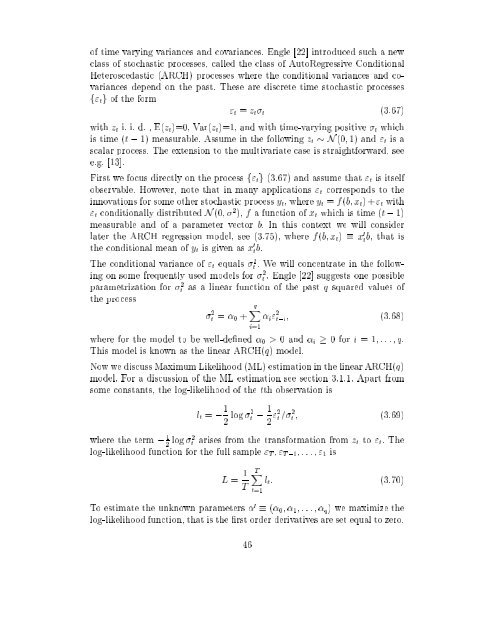Estimation in Financial Models - RiskLab
Estimation in Financial Models - RiskLab
Estimation in Financial Models - RiskLab
You also want an ePaper? Increase the reach of your titles
YUMPU automatically turns print PDFs into web optimized ePapers that Google loves.
of time vary<strong>in</strong>g variances and covariances. Engle [22] <strong>in</strong>troduced such a new<br />
class of stochastic processes, called the class of AutoRegressive Conditional<br />
Heteroscedastic (ARCH) processes where the conditional variances and covariances<br />
depend on the past. These are discrete time stochastic processes<br />
f" t g of the form<br />
" t = z t t (3.67)<br />
with z t i. i. d. , E(z t )=0, Var(z t )=1, and with time-vary<strong>in</strong>g positive t which<br />
is time (t , 1) measurable. Assume <strong>in</strong> the follow<strong>in</strong>g z t N(0; 1) and " t is a<br />
scalar process. The extension to the multivariate case is straightforward, see<br />
e.g. [13].<br />
First we focus directly on the process f" t g (3.67) and assume that " t is itself<br />
observable. However, note that <strong>in</strong> many applications " t corresponds to the<br />
<strong>in</strong>novations for some other stochastic process y t , where y t = f(b; x t )+" t with<br />
" t conditionally distributed N (0; 2 ), f a function of x t which is time (t , 1)<br />
measurable and of a parameter vector b. In this context we will consider<br />
later the ARCH regression model, see (3.75), where f(b; x t ) x 0 tb, that is<br />
the conditional mean of y t is given as x 0 tb.<br />
The conditional variance of " t equals t 2 . We will concentrate <strong>in</strong> the follow<strong>in</strong>g<br />
on some frequently used models for t 2 . Engle [22] suggests one possible<br />
parametrization for t<br />
2 as a l<strong>in</strong>ear function of the past q squared values of<br />
the process<br />
2 t = 0 +<br />
qX<br />
i=1<br />
i " 2 t,i; (3.68)<br />
where for the model to be well-dened 0 > 0 and i 0 for i = 1;:::;q.<br />
This model is known as the l<strong>in</strong>ear ARCH(q) model.<br />
Nowwe discuss Maximum Likelihood (ML) estimation <strong>in</strong> the l<strong>in</strong>ear ARCH(q)<br />
model. For a discussion of the ML estimation see section 3.1.1. Apart from<br />
some constants, the log-likelihood of the tth observation is<br />
l t = , 1 2 log 2 t , 1 2 "2 t = 2 t ; (3.69)<br />
where the term , 1 log 2 2 t arises from the transformation from z t to " t . The<br />
log-likelihood function for the full sample " T ;" T ,1 ;:::;" 1 is<br />
L = 1 T<br />
TX<br />
t=1<br />
l t : (3.70)<br />
To estimate the unknown parameters 0 ( 0 ; 1 ;:::; q ) we maximize the<br />
log-likelihood function, that is the rst order derivatives are set equal to zero.<br />
46
















